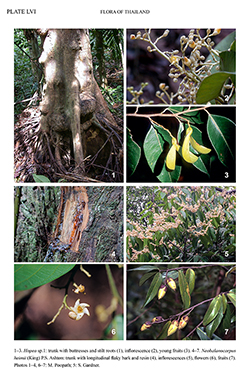e-Flora of Thailand
Volume 13 > Part 4 > Year 2017 > Page 617 > Dipterocarpaceae > Hopea
18. Hopea sp. 1
Plate LVI: 1–3.
Accepted Name : This is currently accepted.
Description : Tree 20–30 m tall, buttresses more or less sharp-edged, frequently with stilt roots; bark smooth to rough, inner bark dark pink to dark red, resin exudations translucent, white. Young twigs scattered pubescent, sparsely puberulent with brown peltate scales, becoming glabrous, lenticellate. Stipules ovate to oblong, 2–3 by 1.5–2 mm, apex obtuse, pubescent outside. Leaves elliptic, oblong, ovate to broadly ovate, 6–11 by 3–6 cm, thickly coriaceous, glabrous or white waxy on both surfaces; base cuneate to obtuse, symmetrical; apex subcuspidate, to ca 1 cm long; margin slightly revolute; nervation dryobalanoid or subdryobalanoid, main nerves (10–)14–18 on each side, basal pair continuing as intramarginal nerves, reaching margin ca one third along; tertiary nerves reticulate or scalariform-reticulate; midrib raised on both sides; petioles 0.7–1.2 cm, glabrous; domatia absent. Inflorescences 1.5–4 cm long, lax, erect, sparsely puberulent with brown peltate scales; bracteoles fugaceous; flower buds ovoid, ca 6 by 3 mm; pedicels ca 2 mm long. Calyx lobes broadly ovate, subequal, sparsely pubescent and with brown peltate scales outside, ciliate at tip; 2 outer with acute apex, ca 3 by 2.2 mm; 3 inner with obtuse apex, 3.2 by 2.7 mm. Petals falcate-oblong, ca 8 by 2–3 mm, apex acuminate and undulate, white to pale yellow. Stamens 15, in 2 whorls; filaments 0.5–0.8 mm long; anthers subglobose, ca 0.2 mm in diam.; connective-appendages 1–3 times as long as anthers, scattered glandular papillose. Ovary ovoid, ca 1 by 0.8 mm, glabrous; stylopodium absent, ovary attenuate to style; style slender, ca 1.3 mm long. Fruiting calyx lobes glabrous; cone-like at base, tapering from longer lobes, thickened, ca 4 mm long; 2 lobes wing-like, 3.5–6.5 by 1–2 cm, veins 7–9, narrow and deeply thickened at base, 7–8 by 5–7 mm, both sides of margins expanded into membrane sheets, ca 2 mm wide, light green when young; 3 short lobes, ovate-lanceolate, 1.5–2.3 by 0.4–0.5 cm, apex acuminate or shortly winged apically to 2 cm long; fruit pedicels ca 2 mm long. Nut ovoid, 1–1.2 by 0.7–0.8 cm, glabrous; style remnant apiculate.
Thailand : PENINSULAR: Narathiwat (Waeng, Sukhirin).
Distribution : Only known in Thailand.
Ecology : Evergreen forests, foothills to ridges, 50–300 m alt. Flowering: March–May; fruiting: June–August.
Vernacular : Chan hom (ชันหอม).
Notes: Several specimens of this species have been collected but could not be matched to any species found in Thailand or Peninsular Malaysia. It is close to Hopea mengerawan Miq. From Peninsular Malaysia, Sumatra and Borneo in leaf characters including the number of secondary nerves but the latter has fissured bark, peltate scales on young twigs and lower surfaces of leaves, villose style base, and fruiting calyx short lobes 3–6 mm long. However, comparison to more specimens of other species in Peninsular Malaysia will be necessary to clarify its status as a new species.

